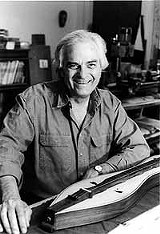News briefs 8.6.03
[
{
"name": "500x250 Ad",
"insertPoint": "5",
"component": "15667920",
"parentWrapperClass": "",
"requiredCountToDisplay": "1"
}
]
Pursuing human perfection
Dwain Wilder gently handles an unfinished dulcimer and tries to explain his passion for building them. "Our world is full of a kind of perfection that has no soul," he says. "It's mechanical. It can be beautiful... look at these cars pouring off assembly lines. But they don't win your heart in the end." Building dulcimers has clearly won Wilder's heart. "It's such a gentle instrument... there's just a sweetness associated with it," he says. In fact, dulcimer means "sweet music."
Wilder, one of five or six full-time dulcimer builders in the US, tailors each instrument to his clients' needs. "I pay attention to what and how they play," he says. "Then I build something specific for them." Many things affect the dulcimer's sound, including the type of wood used. "Spruce has a brash sound," says Wilder. "Redwood is sweet. If you think of Spruce as a nice, tart apple, Redwood is dark chocolate."
With so few builders, you might expect the financial rewards to be great. They're not. "I make a financial sacrifice to do this," he says. "From time to time I have to get a real job to support my building habit." That "real job" is computer programming. Another drawback is the time it takes to build one. Wilder estimates he makes about 11 dulcimers a year for musicians ranging from folk to jazz to blues. He believes it's worth the sacrifice and time.
"When I go to festivals, I take along a carving project and people stop by to watch," he says. "Many come back and say, 'It's wonderful to see someone doing this.' They want to see the touch of the human hand... human perfection, not mechanical perfection. It draws people in and it draws me in, too."
As he speaks about his work, it's obvious that dulcimer building has brought Wilder something that can't be measured in dollars; call it peace, call it contentment. "You don't have to build dulcimers to find what I've found," he says. "Others have found it elsewhere."
For more information and a sampling of Wilder's work, visit www.bearmeadow.com.
--- Joseph Sorrentino
Another matter of importance
County Executive Jack Doyle is hoping the Monroe County Legislature will approve his proposal to sell, by public auction, approximately 28 acres of land on the county's 66-acre IOLA Campus, located near Westfall and East Henrietta Roads.
Doyle's referral was issued as a "matter of importance" on Monday, August 4, two days before the matter would be presented to the county's Ways and Means Committee.
Nearly three years ago, the county selected Flaum Management Co. and Christa Construction, Inc., as "master developer" for the redevelopment of IOLA. (Several county agencies were located at the IOLA Campus before the opening of City Place downtown.)
As part of the agreement with Flaum/Christa, the county paid $252,134 to the architectural and engineering firm Bergmann Associates, which was to prepare a master plan for the site. The master plan, according to a 2000 referral from Doyle, was to "recommend zoning changes to the project site [and] prepare and evaluate alternatives for development."
Ink tried contacting several Ways and Means Committee members, all of whom either did not return calls or declined to comment for lack of information.
But Ink did reach committee member Lynda Garner Goldstein, who says there "are several disturbing aspects of the referral."
"Why is this coming up all of a sudden, out of the blue, as a matter of importance? And why are we dividing up this land? My hunch is that the county's just trying to raise some cash," she says. "But what are the county's plans for the rest of the land?"
Goldstein also says she has never seen the Bergmann master plan. "I've never seen a completed document from them," she says. "There have been several maps and a couple of meetings. But, as far as I know, nothing's been finished, and there have been no neighborhood meetings on this."
The boat stops there (maybe)
Some locals have been persuaded to think the Rochester-Toronto fast ferry project is much on the collective mind of Ontario. So it was a double-barreled blast of reality when Toronto Star business columnist David Crane wrote (July 30) that: (1) "there is still no agreement on a terminal in Toronto" nor cash for customs and immigration services at that end of the line; and (2) that Toronto stands to "benefit more than Rochester from the project, since Toronto will... be a final destination, while much of the traffic to Rochester will be continuing on to other locations."
This shot across the lake even exercised the Democrat & Chronicle enough to run an above-the-fold frontpager. But is there really anything to be surprised at or worried about?
For a second-opinion reality check, we called the Ontario Coalition Against Poverty, a housing and social-justice group based near the University of Toronto. Among other things, OCAP has been fighting homelessness and the acute shortage of affordable housing in Toronto --- grave problems made worse morally by the fact they're allowed to happen in Canada's wealthiest city. Like other social-justice groups, OCAP has tried to steer Ontarians toward saner priorities and a fairer economy, and away from capital-intensive "development" schemes like some aspects of the Waterfront Revitalization and the recent 2008 Olympics bid --- at least till there's enough money to go around.
Mike Coward, an OCAP housing caseworker, told us he'd never heard of the fast ferry project; he doesn't know Rochester, either, though he's familiar with our regional sister city to the west ("I remember when people up here used to go to Buffalo for fun"). So Mike, are Torontonians in your circle eagerly anticipating the Revitalization that will give, ah, berth to the ferry dock? Not exactly. "There's a feeling," he says, "that nothing should be done till housing is taken care of. We should always keep our priorities straight. We have to start worrying about the little people. End poverty first."
The love never stops
Twenty-five years ago, Western New York gave the world a new style of environmental campaign --- and a name that will live in infamy.
"Love Canal was really a turning point in how people think about the environment," says Mike Schade, a Buffalo-based organizer with the Citizens Environmental Coalition, part of a coalition that sponsored commemorative events last week about toxic-waste problems lingering in the Buffalo-Niagara area.
Schade is talking, of course, about William Love's aborted 19th-century canal in what is now the eastern fringe of the city of Niagara Falls, New York. Love planned a significant waterway; but by the mid-20th century, the ditch he left had become a dump for thousands of tons of industrial waste, a residential neighborhood had been created around it, and an elementary school had been built there, as well. Over the years, the highly toxic waste in the now-covered canal "migrated," as they say, into yards and homes. But in 1978, residents-turned-activists --- led by Lois Gibbs, still a leader in the environmental movement --- began forcing government and industry to clean up the mess.
Today the outcome is mixed: Much of the waste remains on-site, isolated and "capped" to prevent further migration. And much of the neighborhood was bulldozed --- though some abandoned homes were eventually rehabbed and resold.
Lois Gibbs, now the Virginia-based director of the Center for Health, Environment, and Justice, came back to Buffalo-Niagara for the recent events. Under the rubric "Love Canals of Today," says Mike Schade, Gibbs and others visited Hickory Woods, a South Buffalo neighborhood where homes were built in a contaminated zone. They also went to sites in Tonawanda, Cheektowaga, and other towns --- including a place where radioactive waste lingers from World War II's Manhattan Project.
But the "Toxic Tour" wasn't all downbeat. The various sites have produced a remarkable citizens' movement. Also, Mike Schade says his group and other Albany-watchers are anticipating a deal between the state Assembly and Senate and Governor George Pataki will soon yield a new Superfund financing measure. Albany has been hung up for years over how stringent the clean-up standards will be (in essence, totally clean or just clean enough to support an industrial re-use of the site) and who will pay (basically, how the costs will be divided between the polluter and the public).
In the meantime, Schade encourages you to check out some websites that detail the mess we Upstate New Yorkers are in. You can go to www.ecothreatny.org, for example, to check out locations of toxic sites near you (they're all over the map). Or you can go to www.childproofing.com for information --- assembled by the Center for Health, Environment, and Justice --- on how to keep your school safe.
A whole lot safer, hopefully, than that now-demolished school near Love Canal.
Speaking of...
-
![[UPDATED] Alyssa Rodriguez gives traditional folk music the holiday treatment in Sunday livestream](https://media1.roccitymag.com/rochester/imager/u/review/12593517/alyssa_rodriguez.jpg)
[UPDATED] Alyssa Rodriguez gives traditional folk music the holiday treatment in Sunday livestream
Dec 8, 2020 -

CityGate plans include a Costco
May 15, 2013 -

Metro ink -12-27-06
Dec 27, 2006 - More »





